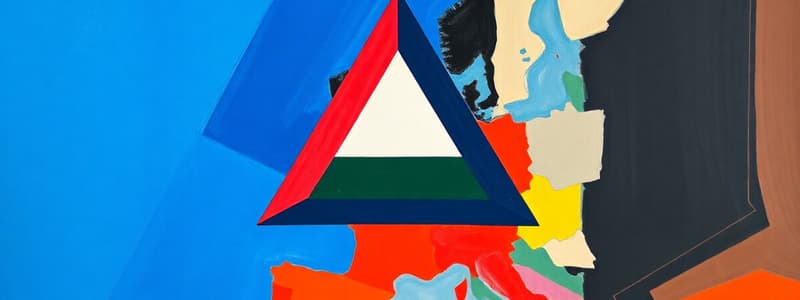Podcast
Questions and Answers
The Weimar Triangle is a ______ group of countries.
The Weimar Triangle is a ______ group of countries.
trilateral
The Weimar Triangle was formed in ______.
The Weimar Triangle was formed in ______.
1991
The Weimar Triangle aimed to build stronger ties between ______, Poland, and France.
The Weimar Triangle aimed to build stronger ties between ______, Poland, and France.
Germany
A primary goal of the Weimar Triangle was to support ______ after World War II.
A primary goal of the Weimar Triangle was to support ______ after World War II.
The Weimar Triangle developed common positions on European ______ and foreign policy.
The Weimar Triangle developed common positions on European ______ and foreign policy.
The Weimar Triangle emphasized strengthening ties between the ______ of the three countries.
The Weimar Triangle emphasized strengthening ties between the ______ of the three countries.
The Weimar Triangle doesn't have a fixed ______ or a rigid organizational structure.
The Weimar Triangle doesn't have a fixed ______ or a rigid organizational structure.
The Weimar Triangle has played a role in promoting ______ and cooperation in Central Europe.
The Weimar Triangle has played a role in promoting ______ and cooperation in Central Europe.
Flashcards
Weimar Triangle
Weimar Triangle
A trilateral group of Germany, Poland, and France formed in 1991.
Post-Cold War Cooperation
Post-Cold War Cooperation
Efforts aimed at building ties among nations after the Cold War.
German-Polish Reconciliation
German-Polish Reconciliation
Efforts to improve relations between Germany and Poland after WWII.
Shared European Vision
Shared European Vision
Signup and view all the flashcards
Flexible Format
Flexible Format
Signup and view all the flashcards
Regular Meetings
Regular Meetings
Signup and view all the flashcards
Promoting Regional Stability
Promoting Regional Stability
Signup and view all the flashcards
EU Influence
EU Influence
Signup and view all the flashcards
Study Notes
Weimar Triangle
- A trilateral group of Germany, Poland, and France
- Formed in 1991
- Aims to foster cooperation and shared vision for Europe
Origins and Objectives
- Post-Cold War Cooperation: Aimed to strengthen ties between nations after the Cold War and German reunification, particularly supporting German-Polish reconciliation.
- Shared European Vision: Developed common positions on European integration, security, and foreign policy issues
- Societal Links: Focused on strengthening ties between societies through cultural exchanges, education programs, and citizen dialogues.
Structure and Functioning
- Flexible Format: No fixed secretariat or rigid structure; driven primarily by foreign ministers.
- Regular Meetings: Occur at various levels (summits, ministerial meetings, consultations) and frequency varies based on context.
- Areas of Cooperation: Covers a broad range of issues including European security, defense, economic policy, cultural exchange, and support for democratic transitions.
Significance and Challenges
- Promoting Regional Stability: Played a role in promoting stability and cooperation in Central Europe, particularly important in addressing regional security concerns like the conflict in Ukraine.
- Influence within the EU: Significant influence on EU policy debates due to coordinated positions of member states, impacting the direction of European integration.
- Maintaining Momentum: Faced fluctuating activity, requiring sustained effort to remain relevant in a changing geopolitical landscape.
- Recent Developments: Recent meetings to reaffirm commitment to cooperation and address current challenges highlight ongoing relevance in fostering dialogue and collaboration.
Studying That Suits You
Use AI to generate personalized quizzes and flashcards to suit your learning preferences.




